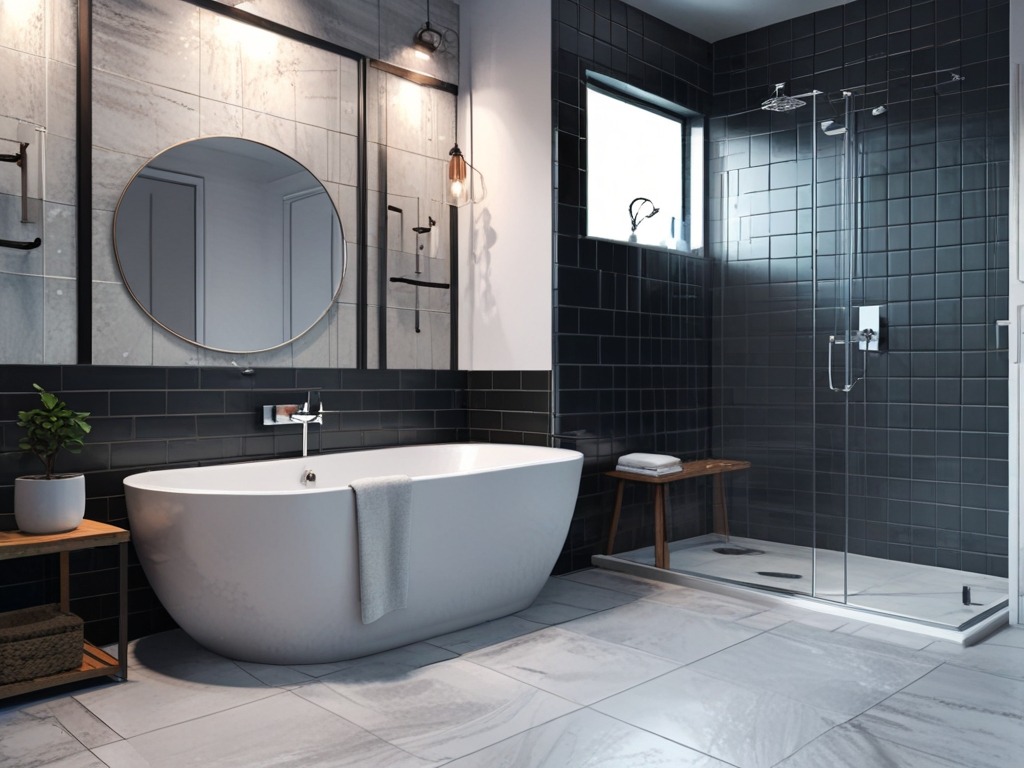
When it comes to designing your dream bathroom, the allure of perfect tips for choosing bathroom tiles can make a world of difference. The right bathroom tiles not only enhance aesthetic appeal but also contribute significantly to functionality and safety within this essential space.
A well-chosen tile can transform an ordinary bathroom into a sanctuary—reflecting your personal style while offering durability against moisture, stains, and daily wear and tear. In India, where the diversity of tile options is as rich as its culture, homeowners are fortunate to explore an array of materials, colors, and patterns that cater to all tastes and budgets.
From elegant porcelain to earthy natural stone and vibrant ceramics, the selections available provide endless possibilities for creating a unique space suited specifically to your lifestyle needs.
With so many choices at your disposal—from trendy subway tiles in chic urban spaces to rustic terracotta in traditional homes—navigating through this plethora can feel overwhelming. This needn’t be the case; with informed guidance, you can confidently curate a harmonious combination that enhances both style and space efficiency.
In the upcoming sections, we will delve into eight essential tips tailored for Indian homeowners that will empower you to make impactful decisions when selecting bathroom tiles—a vital step toward achieving the serene retreat you’ve always envisioned.
1. Assessing Your Bathroom Space
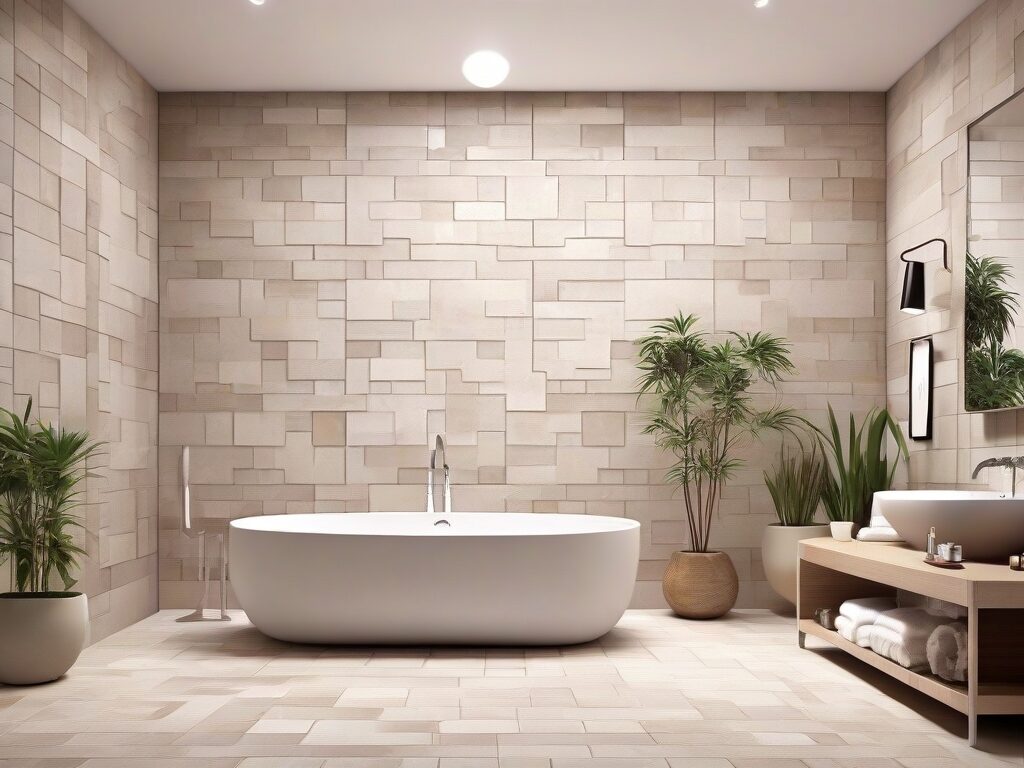
When preparing to choose bathroom tiles, assessing the available space is a critical first step that can greatly influence your final decision. Begin by taking precise measurements of your bathroom dimensions—length, width, and height—ensuring accuracy for tile placement considerations. A common mistake homeowners make is neglecting to account for features like sinks, toilets, and shower enclosures.
For instance, if you’re working with a narrow powder room but want to use large-format tiles that visually expand the space, be mindful to align them carefully around fixtures. Additionally, using software or online design tools may help you visualize how certain tile sizes will fit into your unique layout.
Beyond mere dimensions, evaluating the aesthetics of your bathroom’s design will enhance both functionality and visual appeal.
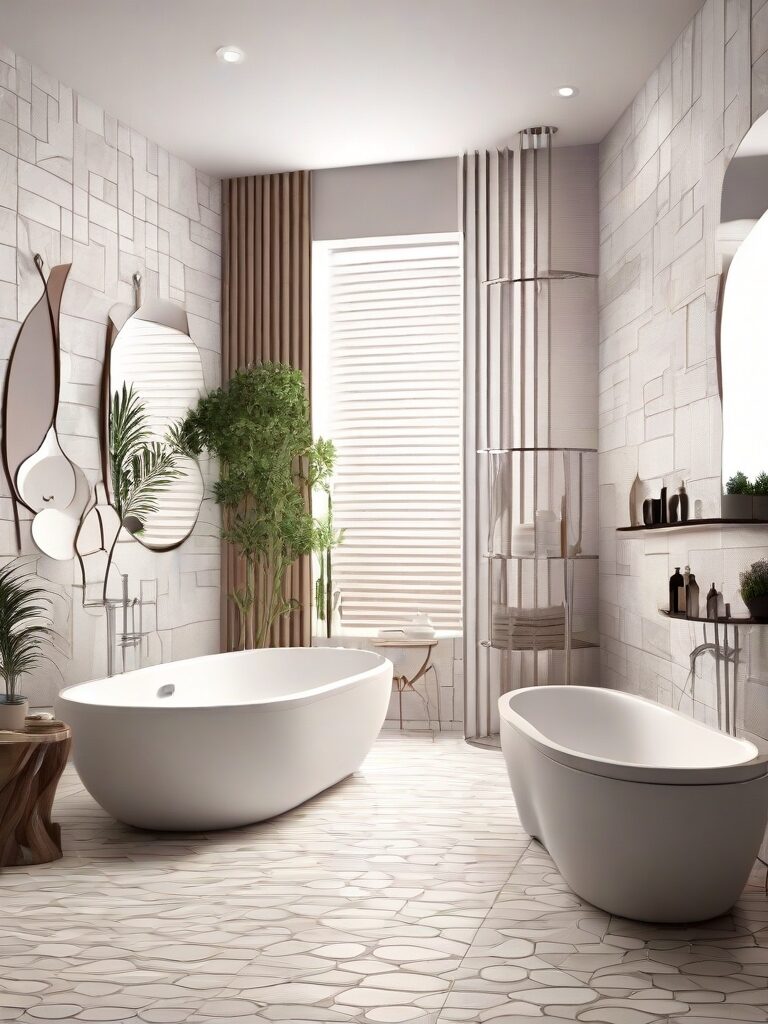
Consider how natural light enters the space; lighter colors tend to reflect light better and can create an illusion of openness in compact bathrooms. If your lavatory has lower ceilings, contrasting grout lines with dark tiles could visually shrink the area even further.
Alternatively, utilizing large tiles with minimal grout lines can give a seamless look that appears more spacious.
Always keep in mind the overarching style of your home; a sleek modern tile may feel out of place in a vintage-inspired decor.
It’s also essential to think about traffic flow when arranging tiles. Will there be enough room for movement around vanities and between doorways?
Ensuring efficiency in layout while simultaneously providing comfort should drive your choice of tile size and placement strategy.
In cases where tile patterns change direction or converge at different points, weighing options like herringbone or diagonal layouts brings interest without compromising accessibility.
Thus demonstrated through adequate space assessment and thoughtful planning, making informed choices becomes easier as you lay down each firm’s foundations toward tiling success!
2. Material Matters: Choosing the Right Tile Type
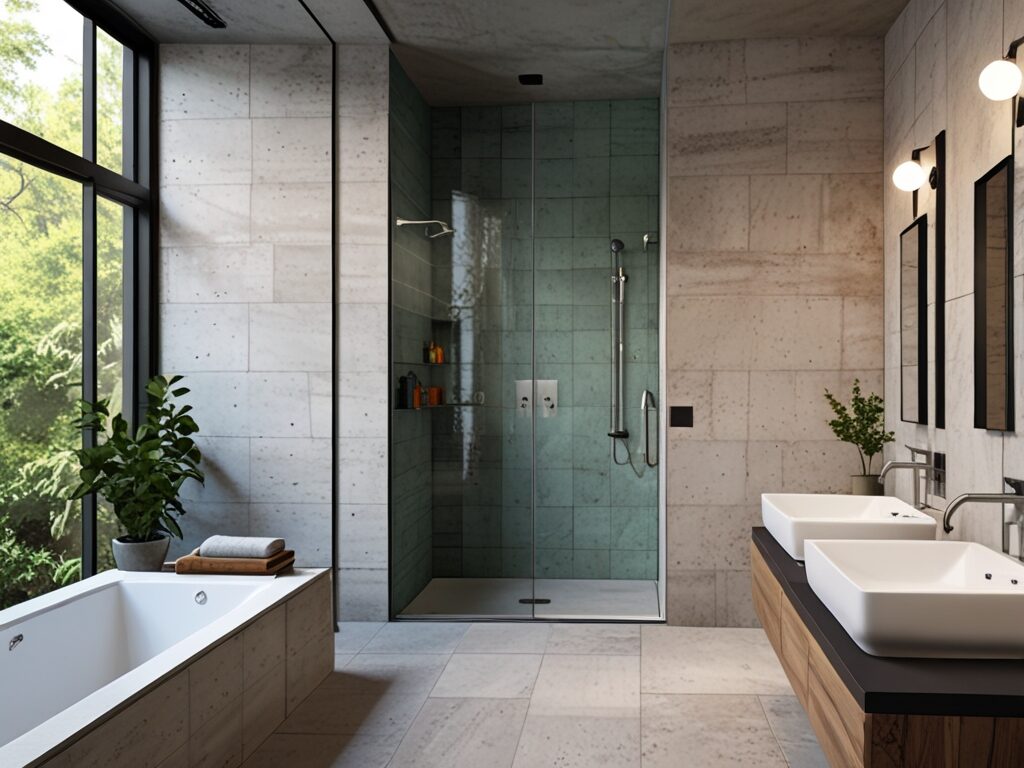
When it comes to selecting bathroom tiles in India, the material you choose plays a crucial role in both functionality and aesthetics. The three most popular tile materials are ceramic, porcelain, and natural stone, each offering unique advantages and drawbacks.
For instance, ceramic tiles are a common choice for their affordability and wide range of designs. Made from clay that is fired at high temperatures, they resist moisture well when glazed. However, ceramic can be softer than other options and might chip or scratch more easily in high-traffic areas.
Porcelain tiles elevate the standard set by ceramic ones through denser construction and enhanced durability. They are particularly suitable for bathrooms as they exhibit excellent water resistance and are less porous than their ceramic counterparts.
This makes them less prone to stains and mildew growth, ideal for humid environments typical of Indian bathrooms. However, porcelain tiles do tend to be heavier and may require professional installation due to their weight.
Despite this, many homeowners appreciate the investment as these tiles can imitate the look of natural stones while providing greater durability over time.
Natural stone tiles like marble, granite, or slate bring an element of luxury to any space with their exquisite visual characteristics. Each stone piece is unique—no two pieces share exactly the same pattern or shade—allowing for highly personalized design aesthetics.
Their resilience against wear makes them a favored option among many homeowners; however, special care during installation is paramount since sealing procedures differ based on the type of stone used. One drawback is that natural stones can be quite porous if not properly sealed—making maintenance a bit more demanding as stains can occur if spills aren’t quickly addressed.
Ultimately, choosing the right tile material involves understanding your specific needs concerning style preferences, maintenance capabilities, budget constraints, and how well you want your selected tiles to hold up against humidity in your bathroom environment.
It’s essential to evaluate all factors before making a decision—what works beautifully in one home may not suit another’s requirements or aesthetic vision!
3. Slip Resistance: Safety First Tips for Choosing Bathroom Tiles
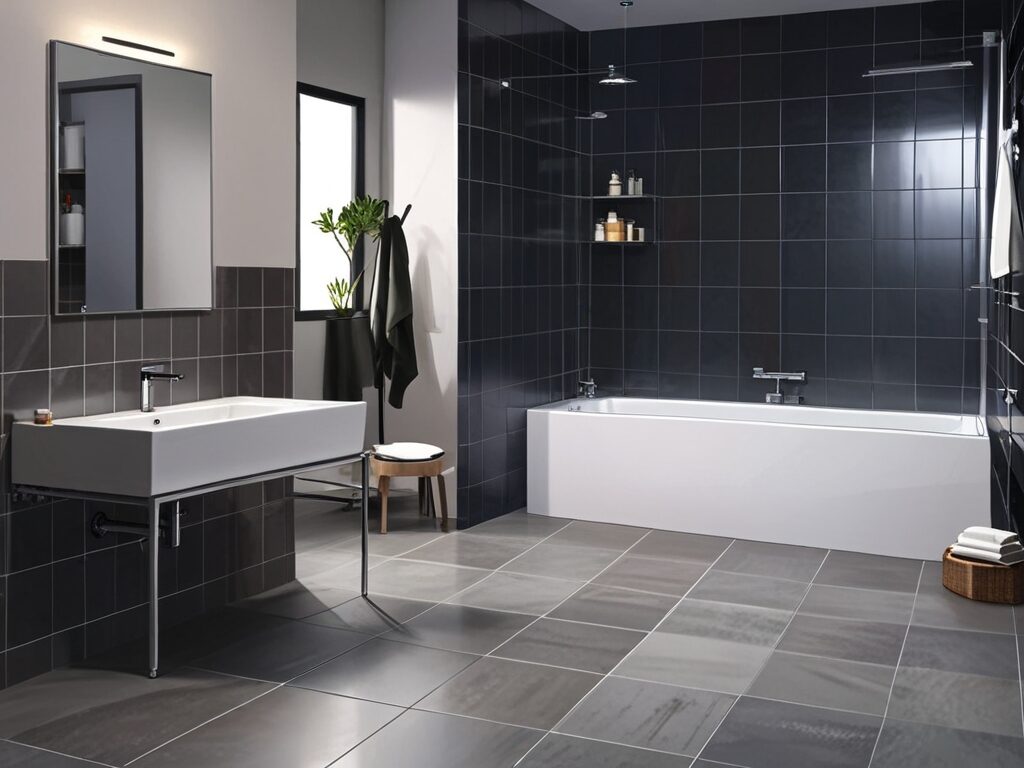
When it comes to bathroom design, safety should always be a top priority, particularly in wet areas where the risk of slips and falls is significantly heightened. This is especially true in bathrooms, where water from showers, sinks, and bathtubs can create hazardous conditions.
Choosing slip-resistant tiles not only protects your loved ones but also provides peace of mind as you navigate through your home. In India, where monsoons can lead to excess moisture indoors, investing in the right tile materials becomes even more crucial for maintaining safety.
To ensure adequate slip resistance, look for tiles rated with a coefficient of friction (COF) that indicates their grip levels.
Tiles with a COF rating of 0.6 or higher are generally considered safe for wet spaces. Porcelain tiles often fit this bill admirably due to their dense structure and low absorbency, making them an excellent choice for bathrooms.
Additionally, specific textures—like weathered surfaces or those featuring slight relief patterns—can enhance traction further without compromising style. For example, raw-textured porcelain tiles offer both aesthetic appeal and functionality by preventing slips while adding organic charm to your space.
In terms of finishes, consider opting for matte or honed finishes over glossy varieties. While shiny tiles may initially seem appealing due to their reflective properties and ease of cleaning, they can become dangerously slippery when wet.
A great alternative would be ceramic tiles designed with anti-slip treatments or those embedded with micro-grip technology specifically made for wet areas. These options not only elevate the safety factor but also contribute aesthetically by bringing a modern touch that resonates well with current bathroom trends.
Ultimately, prioritizing slip resistance during tile selection ensures an enjoyable bathroom experience without compromising on style or design sophistication.
By thoughtfully considering textures and finishes that enhance safety—we’re talking about combining practical choices with striking visuals—you create a space that celebrates both form and function while safeguarding the everyday lives within it.
4. Color and Style Considerations Tips for Choosing Bathroom Tiles
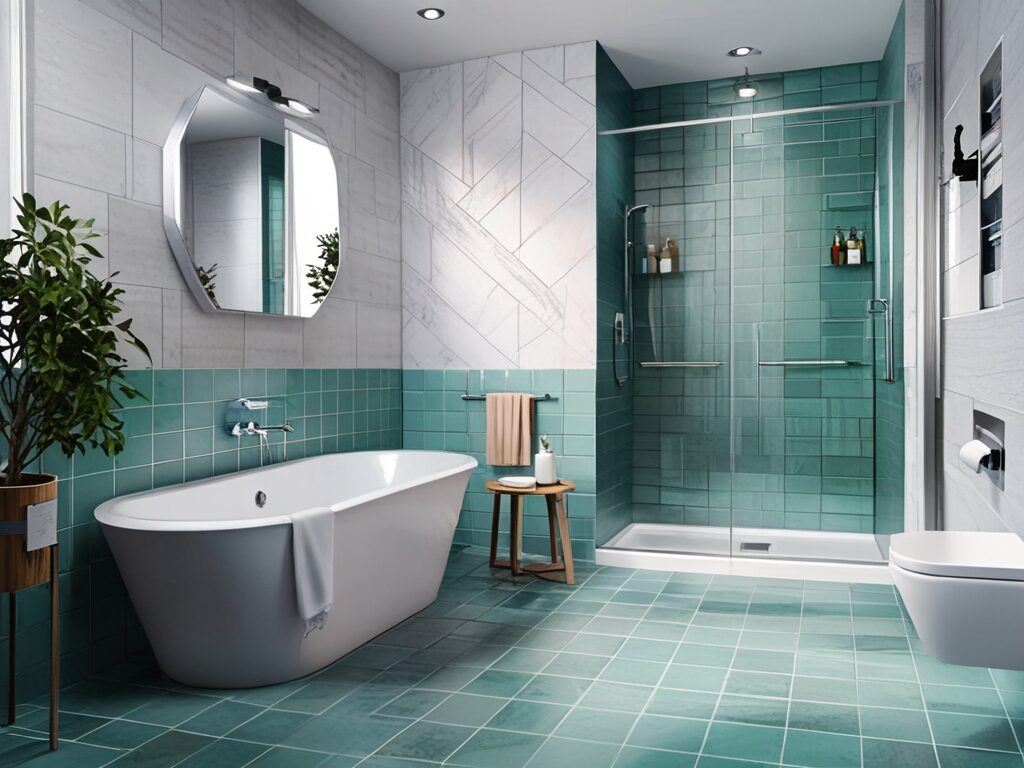
Selecting the right colors and styles for bathroom tiles can significantly influence both the aesthetics and the perceived size of your space. Lighter hues, such as soft whites, pale blues, or muted greens, tend to create an illusion of openness and airiness. This is particularly beneficial for smaller bathrooms where maximizing visual space is essential.
On the other hand, darker shades like deep navy or charcoal can add a dramatic touch but may make a room feel cozier—or even cramped—if used excessively. It’s all about finding balance; for example, using dark tiles on one accent wall while keeping the others light creates depth without overwhelming the room.
As trends evolve, current styles in Indian bathroom tiles showcase a charming mix of classic elegance and modern minimalism. Geometric patterns are making waves this year, adding personality without compromising sophistication.
Proper ideas for color and style consideration
For instance, encaustic tiles featuring intricate motifs can create focal points that draw attention while stylishly breaking up bland spaces. Additionally, large-format tiles are trending due to their sleek look and reduction in grout lines—ideal for achieving that seamless appearance which enhances cleanliness and flow.
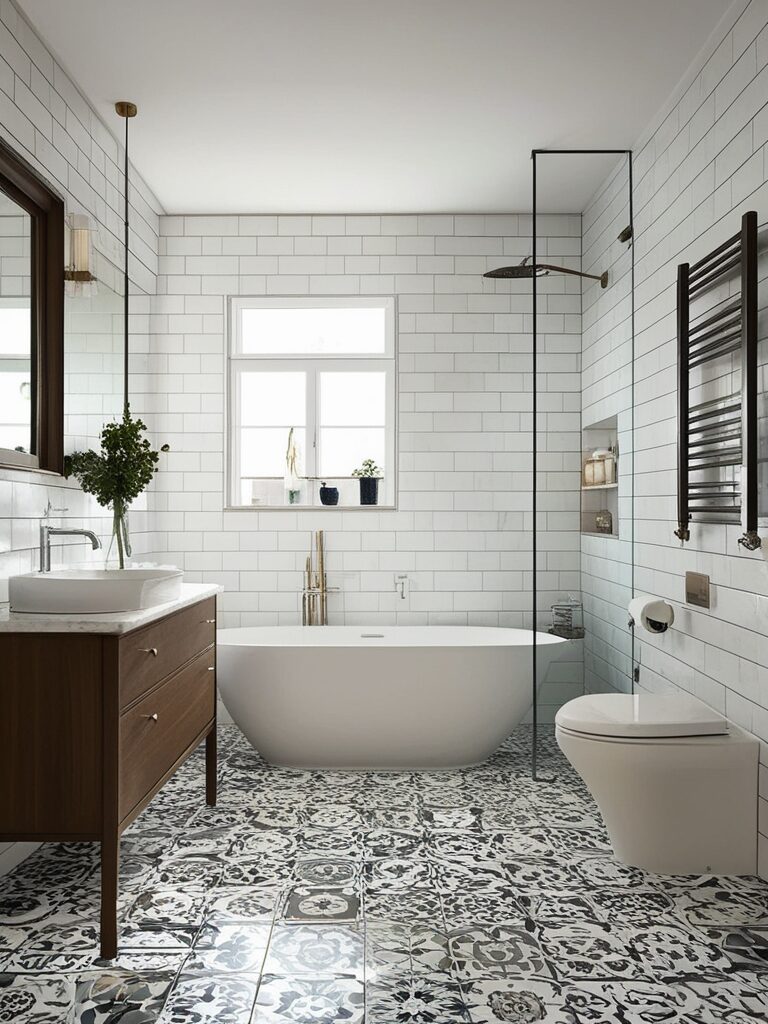
Another trend that has gained traction is the use of natural materials such as stone-effect porcelain tiles.
These designs mimic various natural stones—from marble to slate—bringing in an element of luxury while ensuring durability and low maintenance.
It’s important to consider how these styles reflect your personal taste; creating a serene spa-like atmosphere with neutral tones could be ideal if relaxation is key for you.
Ultimately, don’t shy away from experimenting with color combinations or tile formats that resonate with your vision for your bathroom oasis.
Sample swatches can offer clarity on how different colors work together under various lighting conditions throughout the day.
By merging functionality with aesthetic appeal, you position yourself toward a bathroom design that not only meets your practical needs but also becomes a soothing retreat reflective of your unique style.
5. Budgeting for Your Bathroom Tiles
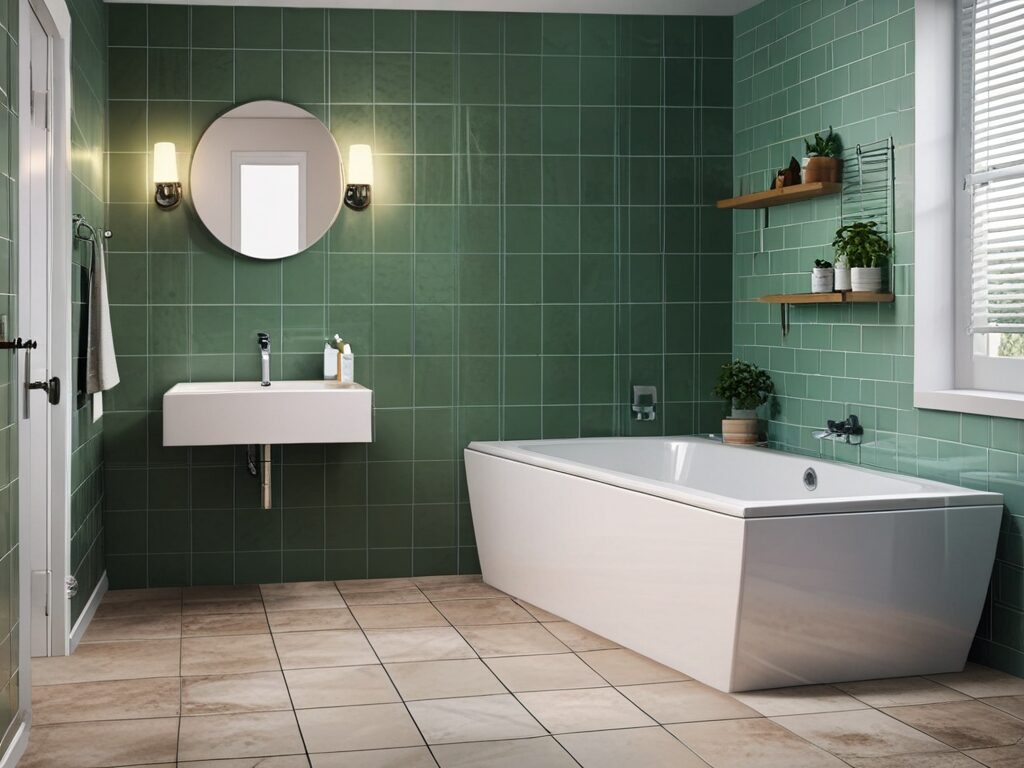
When embarking on a bathroom renovation or redesign, establishing a budget is paramount. Tiles are often one of the most significant investments in this project and can vary dramatically in price.
Generally, ceramic tiles fall on the lower end of the spectrum, costing around ₹30-₹100 per square foot. Conversely, high-end options like natural stone tiles or designer porcelain can range from ₹150 to over ₹500 per square foot.
Therefore, it is crucial to assess your total space coverage and calculate how many square feet you will need to cover efficiently, factoring in a little extra for breakage and cuts during installation.
Finding quality tiles within your budget requires extensive research since India boasts an array of manufacturers and suppliers across regions.
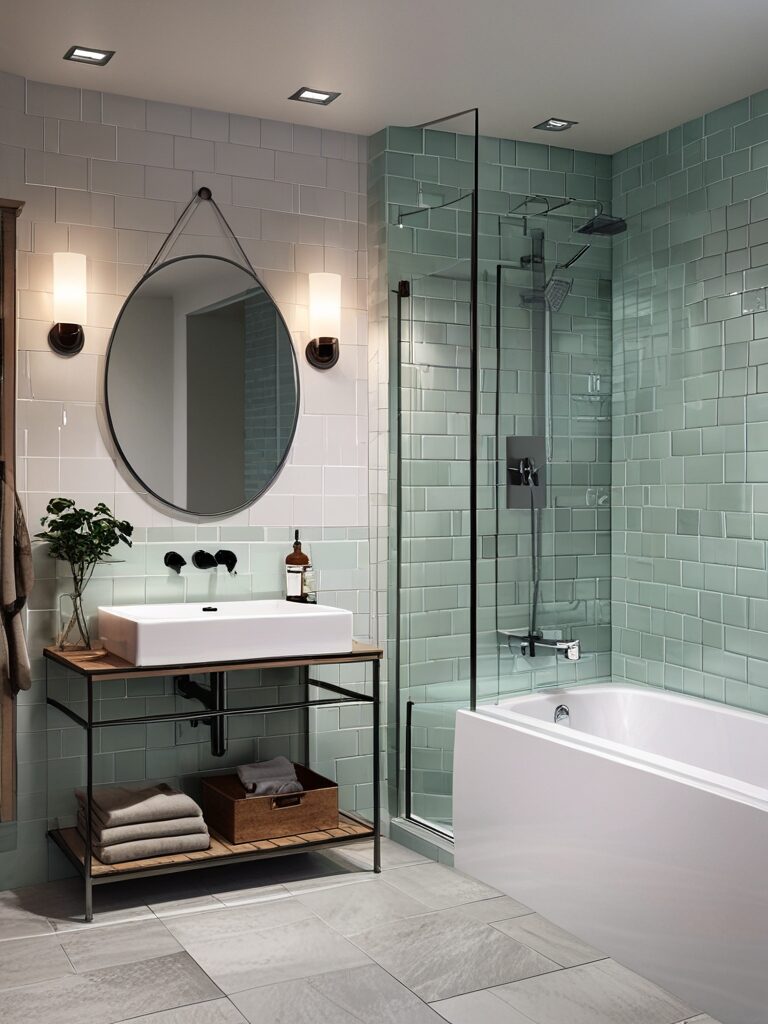
Some Budgetary ideas
A great approach is to explore local tile markets where you might stumble upon exclusive deals or bulk discounts while also supporting regional artisans.
For example, visiting showrooms could give you a tactile experience with different finishes and styles, enabling you to make informed choices without overspending.
Additionally, consider exploring online platforms that specialize in home improvement materials; many provide extensive catalogs—sometimes at reduced prices—that can help streamline your selections based on reviews and user feedback.
Once you’ve established a budget range for your chosen tile type, it’s wise to leave some breathing room for unexpected costs, such as surface preparation or additional materials required during installation like adhesives and grout.
For instance, if you opt for intricate mosaic patterns that require professional installation due to their complexity, you may need to adjust your budget accordingly. Setting aside 10-15% of your total tile budget specifically for contingency can save headaches later.
Finally, don’t forget about color coordination while budgeting! It’s not just about picking the perfect tiles but also ensuring they fit well together within the entirety of your space without stretching finances too thin.
Sometimes opting for more understated yet stylish neutral-toned tiles allows room in the budget for accent features like decorative borders or trendy fixtures that add personality without compromising quality elsewhere. Remember: strategic planning now sets the stage for both aesthetic enjoyment and long-term value!
6. Tiles Installation Tips and Techniques
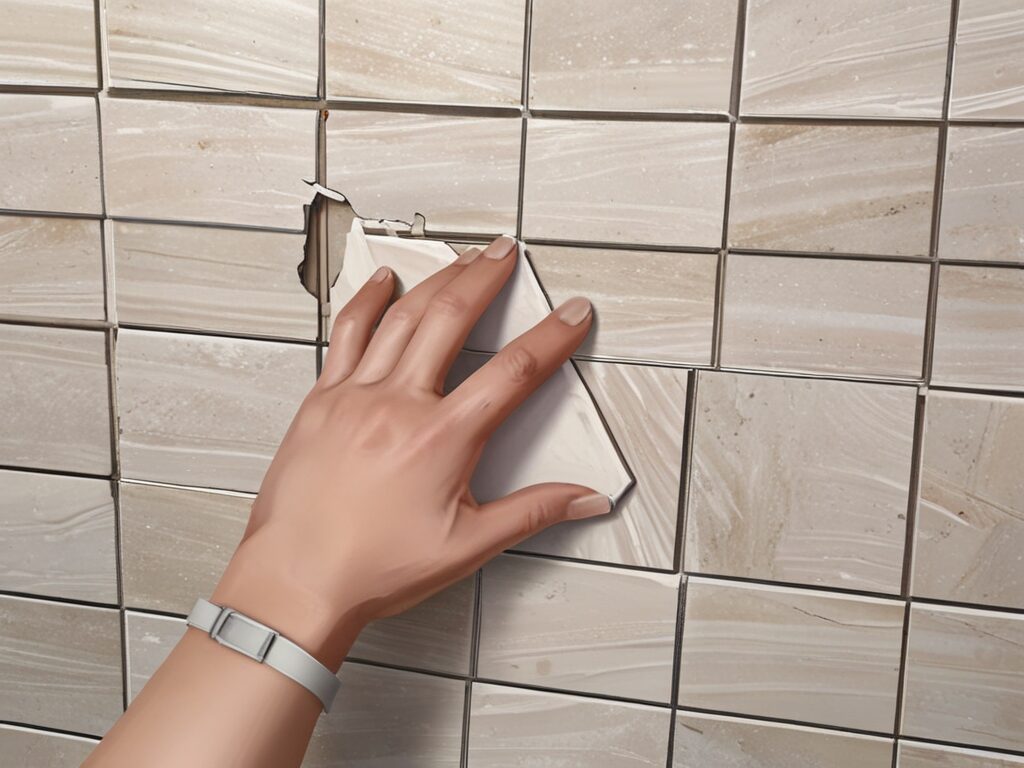
When it comes to installing bathroom tiles, you face a crucial decision: to hire a professional or take the DIY route. While opting for a professional can add to your costs, their expertise often results in a flawless finish that enhances the overall appeal of your bathroom.
Professional tilers are skilled in identifying potential problems—such as uneven subfloors or moisture issues—that might not be immediately apparent to an untrained eye.
On the other hand, if you’re resourceful and prepared to invest time into learning the process, a DIY installation can not only save you money but also give you a great sense of accomplishment. Just keep in mind that mistakes made during self-installation can be costly and difficult to fix later.
If you decide on the DIY path, having the right tools is non-negotiable for achieving a successful installation. At minimum, you’ll need tile spacers, a level, a tile cutter (wet saw recommended for clean cuts), trowels for spreading adhesive, grout floats, and safety gear like goggles and knee pads.
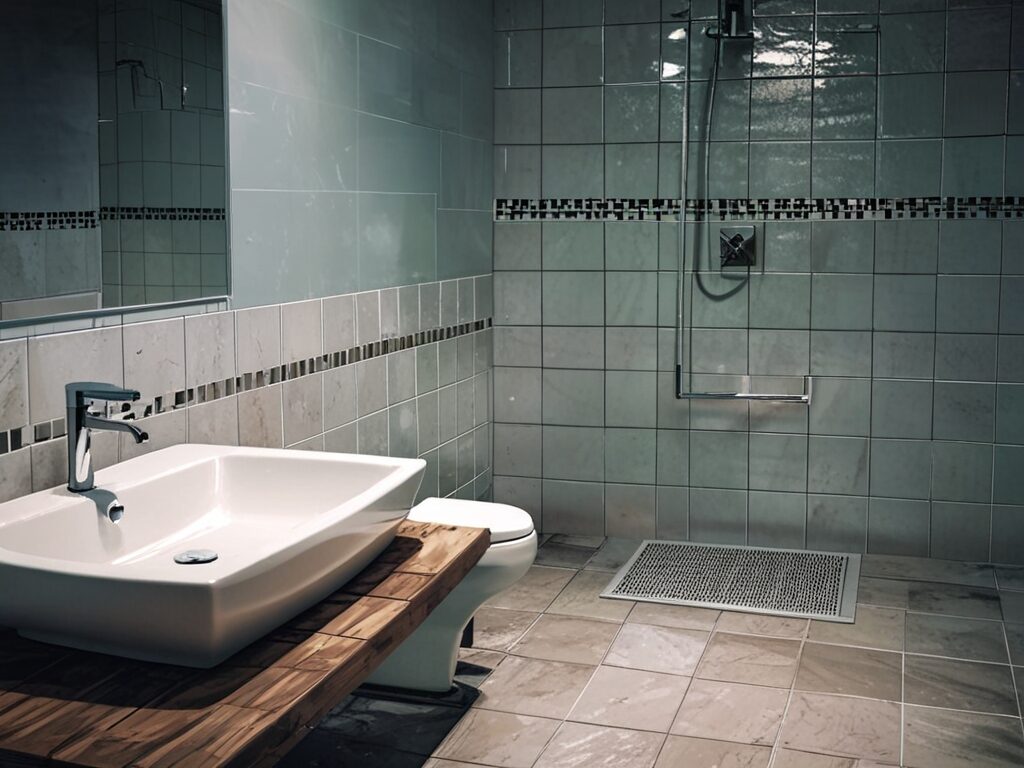
Great tips for Tiles installation
Before you start laying tiles, it’s vital to prepare your space adequately. This includes ensuring proper measurements are taken so that tiles fit seamlessly with minimal cuts—a common cause of frustration during layout.
Another important preparation step is addressing any surface issues beforehand. If you’re working with old tiles being replaced, make sure they’re removed properly without damaging the underlying structure.
For new installations on raw surfaces like cement board or plywood, ensure they are leveled; this aids in avoiding lippage (where corners of tiles become uneven). Avoiding these pitfalls ensures your finished project is both beautiful and lasting.
While planning for tile installation can seem daunting at first glance, meticulous attention to details will pay off tremendously down the line—both in aesthetics and durability. Whether hiring pros or going it alone, preparing thoughtfully will make all the difference in how peaceful your next bath becomes!
7. Maintenance and Care Tips for Choosing Bathroom Tiles
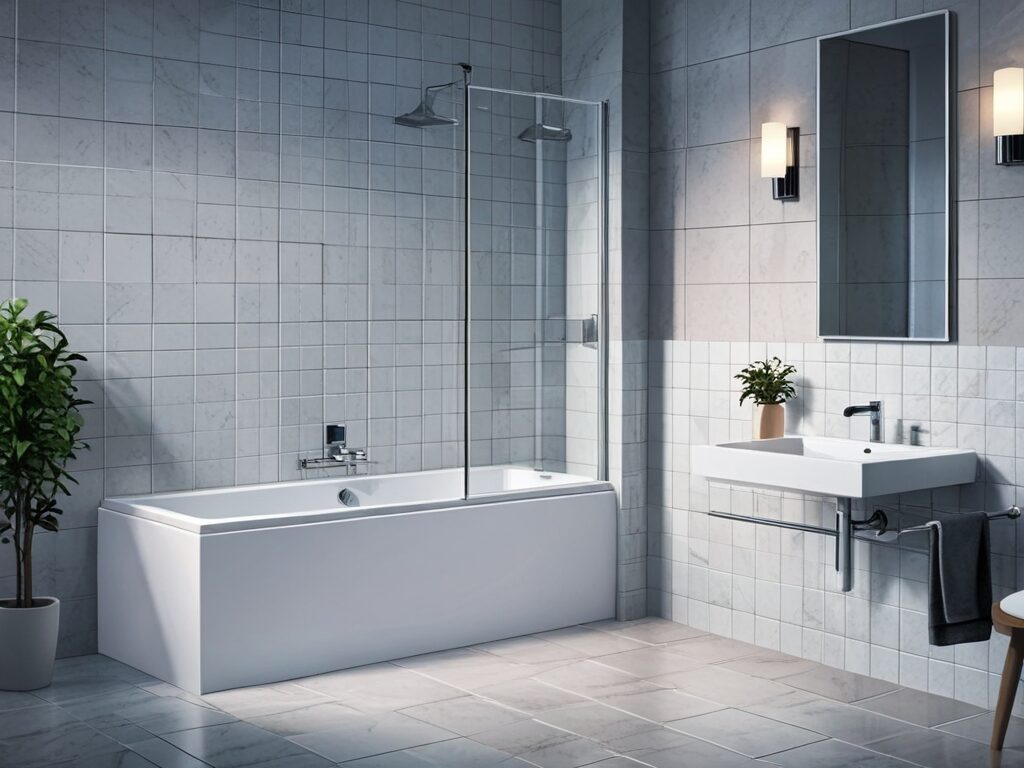
Maintaining your bathroom tiles is crucial for keeping them looking fresh and ensuring their longevity. Different tile materials require different cleaning methods; understanding these nuances can make all the difference.
For instance, ceramic tiles are generally more resilient to stains and scratches, making them low-maintenance. A simple weekly sweep followed by mopping with a mild detergent will typically suffice. However, avoid acidic cleaners as they may dull the glossy finish on the surface.
In contrast, natural stone tiles like marble or slate need a bit more attention; they should be sealed properly upon installation to prevent moisture penetration. Regularly sweeping and using pH-neutral cleaners will help maintain their unique beauty without risking damage.
In terms of preventive measures, regular maintenance is key to prolonging the lifespan of your bathroom tiles. If you have a high foot traffic area, consider placing mats or rugs in strategic locations to catch water spills before they reach your tiles.
More maintenance and care ideas for bathroom tiles
Additionally, it’s wise to periodically check the grout lines for signs of wear or damage; this is a common weak point where mold can develop if neglected. Keeping an eye out for cracks or chips in the tiles themselves allows for timely repairs before those issues escalate into larger problems.
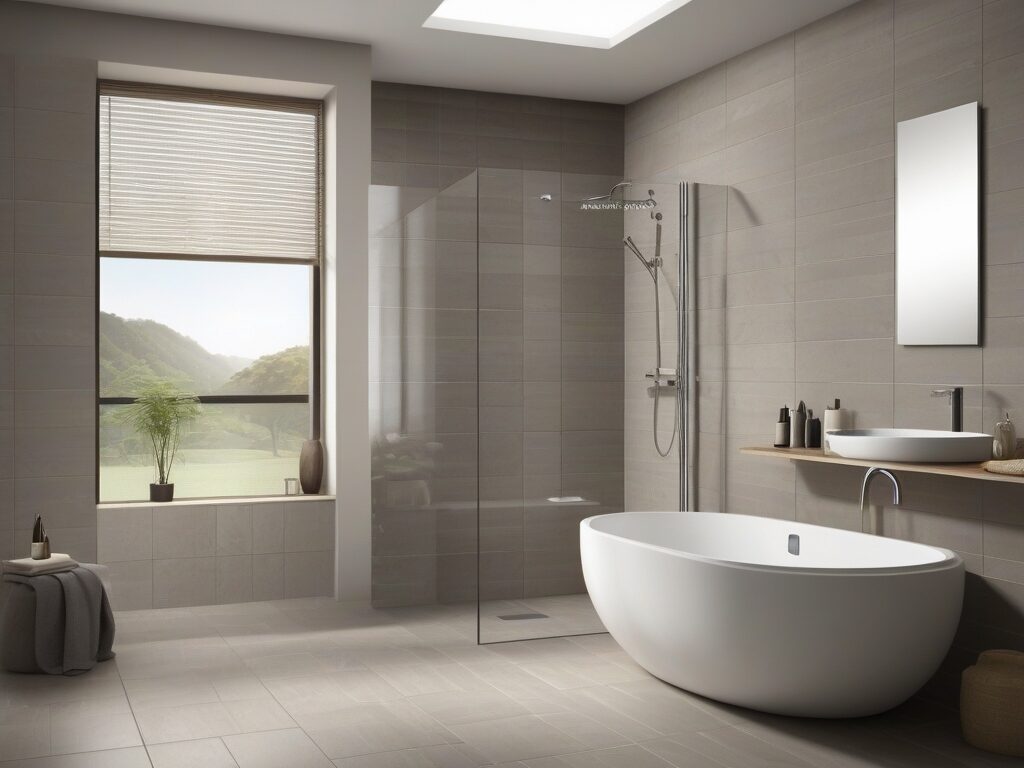
For those who opt for unglazed or textured tiles that may collect dirt and grime more easily, investing in specialized cleaning brushes or soft scrubbing pads can enhance cleanliness without compromising tile integrity.
Furthermore, adopting a ‘no shoes’ policy within the bathroom environment limits how much dirt enters the space in the first place—consider this an effective yet simple preventative strategy! By implementing these cleaning tips and preventive measures based on your specific tile types, you can significantly extend their aesthetic appeal and functionality over time.
Ultimately, consistent care tailored to the specific needs of your chosen materials not only keeps your bathroom visually appealing but also reinforces its value in your home investment journey. Remember that well-maintained tiles contribute significantly to overall hygiene—an essential factor in any home—and create an inviting atmosphere conducive to relaxation and personal care.
8. Common Mistakes to Avoid When Choosing Tiles for Bathroom
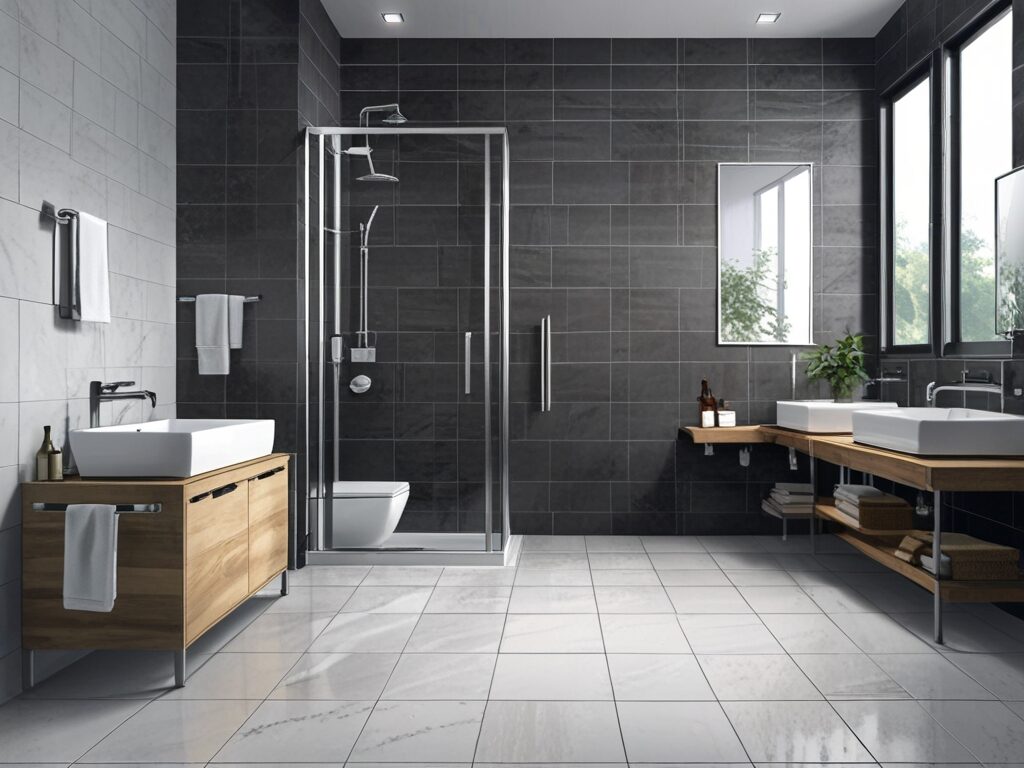
Choosing bathroom tiles can be an overwhelming task, and it’s easy for homeowners to make critical mistakes during the selection process. One common pitfall is failing to consider the tile size in relation to the bathroom dimensions.
For instance, if you choose large format tiles for a compact space, it can lead to a disjointed look, making the area feel even smaller. Conversely, tiny mosaic tiles might work perfectly in a spacious bathroom but can overwhelm a small one. A balanced approach, such as opting for medium-sized tiles with some larger accent pieces, can create harmony within your design.
Another common blunder lies in disregarding color cohesion throughout your bathroom. Many people become enamored with bold colors or patterns without considering how they interact with other elements—like cabinetry, fixtures, or wall paint.
For example, using vibrant colored tiles on the floor coupled with dark-toned cabinetry may inadvertently clash and draw attention away from the overall aesthetic you intended to create. It’s essential to visualize how different colors will complement each other and maintain a cohesive style that resonates throughout your sanctuary.
Some other mistakes for Bathroom Tiles installation
Additionally, overlooking texture variation often leads homeowners astray. Many troubles arise when all tile surfaces are glossy or very similar in texture; this not only risks looking monotonous but also presents practical issues like increased slipperiness.
Instead of selecting uniform gloss finishes across all surfaces—walls included—consider incorporating textures that provide interest while enhancing safety. Utilizing textured tiles for flooring combined with smooth wall finishes creates visual intrigue while ensuring a safer environment where slipping isn’t a constant concern.
Lastly, many homeowners neglect functionality when drawn into intricate designs and elaborate patterns. While artistic flair adds character to bathrooms, it’s important not to compromise on practical aspects like ease of cleaning and maintenance requirements.
Detailed grout lines can harbor bacteria and mold more easily than larger tile formats with wider spaces between them. Before sealing the deal on any ornate design element, ensure it meets both aesthetic desires and realistic upkeep expectations for longevity—a vital step towards achieving that immaculate finish we all seek in our bathrooms.
Final Thoughts on Choosing Bathroom Tiles
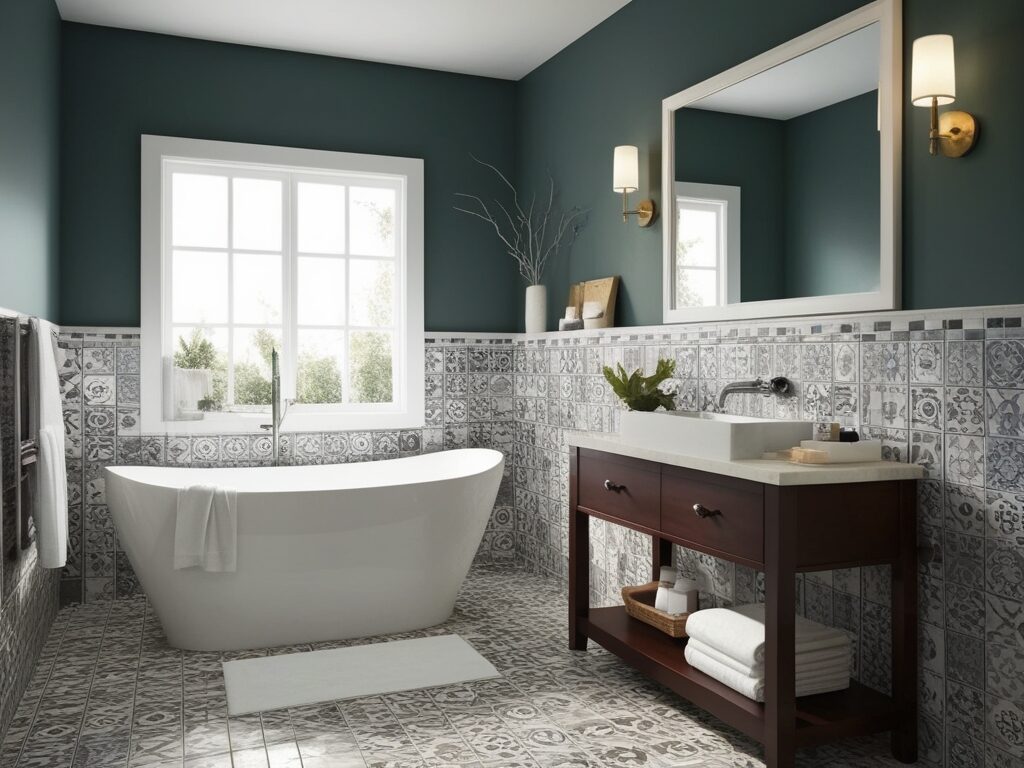
In conclusion, selecting the right bathroom tiles is a multifaceted process that requires careful consideration of various aspects. From understanding the unique materials available—such as ceramic, porcelain, and natural stone—to ensuring safety with slip-resistant options and making budget-conscious decisions, each step plays a crucial role in your project’s success.
Remember to assess your space accurately and stay informed about current design trends to create a harmonious aesthetic in your bathroom. For example, opting for light-colored tiles can open up a small space visually while adding vibrancy to the overall feel.
Don’t rush through this important decision-making process; taking the time to thoroughly evaluate all aspects will not only help you avoid common pitfalls but also lead to an optimal outcome that you’ll cherish for years to come.
Whether you’re a homeowner embarking on a design journey or an interior designer looking to enhance client projects, commit yourself to these tips for choosing bathroom tiles is the proper guidelines for selecting bathroom tiles wisely. The result will be not only functional but artistically pleasing and aligned perfectly with your vision.
Some Bathroom Tiles Material You Need
Answer: Key factors include moisture resistance, durability, tile size and shape, texture for slip resistance, color scheme, and overall design aesthetics.
Answer: Yes, ceramic and porcelain tiles are popular due to their water resistance. Natural stone can also be used but requires sealing to prevent water damage.
Answer: Larger tiles can make a small bathroom appear bigger, while smaller tiles can add detail in larger spaces. Consider balancing size with your design vision and layout.
Answer: A matte finish is often preferred for floors due to its slip-resistance, while glossy finishes can work well on walls or backsplashes for a sleek look.
Answer: Absolutely! Mixing styles can create visual interest. Just ensure they complement each other in terms of color and texture.
Answer: Regular cleaning with mild detergents and avoiding harsh chemicals will help maintain the appearance. For natural stones, periodic sealing may be necessary.
Answer: Light colors like whites, pastels, or soft neutrals can make a small space feel larger. Adding accents with darker shades can provide depth without overwhelming the area.
Answer: Yes! Look for sustainably sourced materials like recycled glass or certified eco-friendly ceramics to reduce environmental impact while enhancing your space’s aesthetics.







